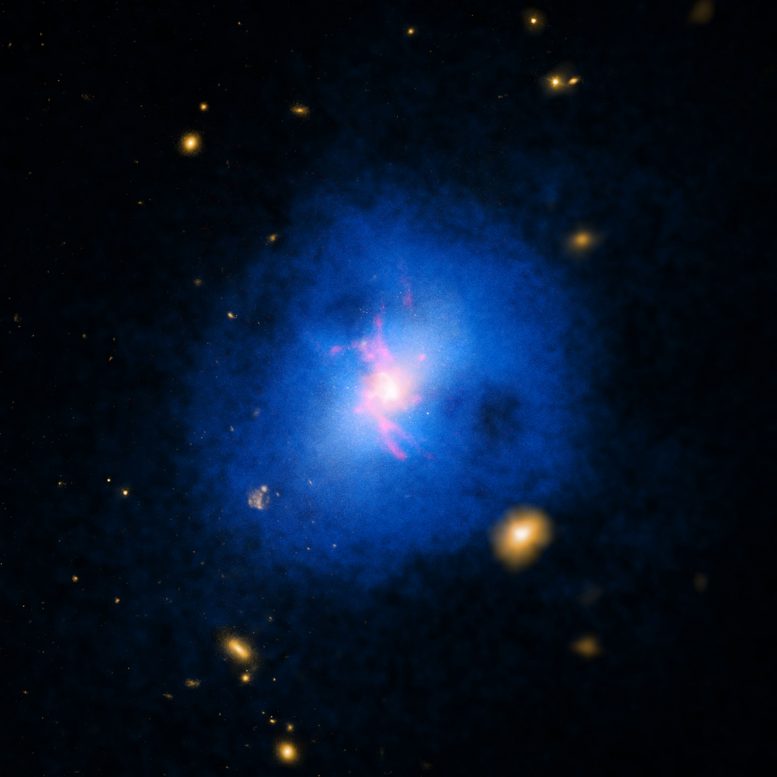
An image of the bright cluster galaxy Abell 2597 in the X-ray (blue), hydrogen line emission (red), and optical (yellow). Astronomers using multi-wavelength observations from the millimeter to the X-ray have concluded, in agreement with predictions, that this galaxy is both accreting gas from its surroundings and ejecting material out from its supermasssive black hole, thus acting like a cosmic fountain.
Most galaxies lie in clusters containing from a few to thousands of other galaxies. Our Milky Way, for example, belongs to the Local Group cluster of about fifty galaxies whose another large member, the Andromeda galaxy, is about 2.3 million light-years away. Clusters are the most massive gravitationally bound objects in the universe and form (according to current ideas) in a “bottoms-up” fashion with smaller structures developing first and with dark matter playing an important role. Exactly how they grow and evolve, however, depends on several competing physical processes including the behavior of the hot intracluster gas.
The galaxy Abell 2597 lies near the center of a cluster about one billion light-years away in the midst of a hot nebula (tens of millions of degrees) of cluster gas. Astronomers have long theorized that intergalactic matter like the plasma around Abell 2597 can fall onto galaxies, cool, and provide fresh material for the galaxy’s star formation. They have, however, also discovered the opposite activity: galaxies’ central supermassive black holes are ejecting jets of material back out into the hot intracluster medium. CfA astronomers Grant Tremblay, Paul Nulsen, Esra Bulbul, Laurence David, Bill Forman, Christine Jones, Ralph Kraft, Scott Randall, and John ZuHone led a large team of colleagues studying the behavior of the hot gas and these competing processes in Abell 2597 using a wide range of observations including new and archival ALMA millimeter observations, optical spectroscopy, and deep Chandra X-Ray Observatory images.
The sensitive and wide-ranging datasets enabled the scientists to probe the thermodynamic character and motions of the hot gas (including both infall and outflow streams), the cold, star-forming dust clouds in the galaxy, and the relative spatial arrangement of all these ingredients. They find detailed support for the models, including both infall of hot material into the galaxy and its subsequent conversion into new stars and as well as the outflow of gas driven by jets from the central supermassive black hole. They show that the warm and cold material are actually found together in this galaxy (although they are of different densities), with clouds of cold gas likely feeding the black hole and apparently coupling to the powerful jets ejected from the nucleus. The result is that the molecular and ionized nebula at the heart of Abell 2597 is what they term a galaxy-scale “fountain:” cold gas drains into the reservoir created by the presence of the black hole at the center, and this powers outflowing jets that, in turn, later cool and sink, raining back down. Because the outflowing material does not move quickly enough to escape the galaxy’s gravity, they conclude that this dramatic galactic fountain seems likely to be long-lived. It may also be a common occurrence in these massive clusters, helping to explain the cosmic evolution of galaxies.
Reference: “A Galaxy-scale Fountain of Cold Molecular Gas Pumped by a Black Hole” by G. R. Tremblay, F. Combes, J. B. R. Oonk, H. R. Russell, M. A. McDonald, M. Gaspari, B. Husemann, P. E. J. Nulsen, B. R. McNamara, S. L. Hamer, C. P. O’Dea, S. A. Baum, T. A. Davis, M. Donahue, G. M. Voit, A. C. Edge, E. L. Blanton, M. N. Bremer, E. Bulbul, T. E. Clarke, L. P. David, L. O. V. Edwards, D. Eggerman, A. C. Fabian, W. Forman, C. Jones, N. Kerman, R. P. Kraft, Y. Li, M. Powel, S. W. Randall, P. Salomé, A. Simionescu, Y. Su, M. Sun, C. M. Urry, A. N. Vantyghem, B. J. Wilkes and J. A. ZuHone, 17 September 2018, The Astrophysical Journal.
DOI: 10.3847/1538-4357/aad6dd

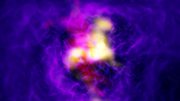
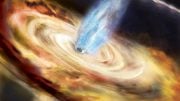

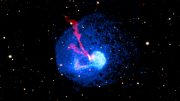

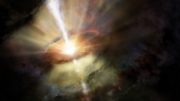
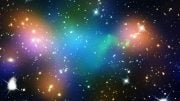
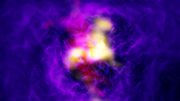
Citation:Hawkings radiation must have 12 fire , earth air water ,repeated sectors surrounding I a blackhole
The sensitive and wide-ranging datasets enabled the scientists to probe the thermodynamic character and motions of the hot gas (including both infall and outflow streams), the cold, star forming dust clouds in the galaxy, and the relative spatial arrangement of all these ingredients. They find detailed support for the models, including both infall of hot material into the galaxy and its subsequent conversion into new stars and as well the outflow of gas driven by jets from the central supermassive black hole. They show that the warm and cold material are actually found together in this galaxy (although they are of different densities), with clouds of cold gas likely feeding the black hole and apparently coupling to the powerful jets ejected from the nucleus.
The result is that the molecular and ionized nebula at the heart of Abell 2597 is what they term a galaxy-scale “fountain:” cold gas drains into the reservoir created by the presence of the black hole at the center, and this powers outflowing jets that, in turn, later cool and sink, raining back down. Because the outflowing material does not move quickly enough to escape the galaxy’s gravity, they conclude that this dramatic galactic fountain seems likely to be long-lived. It may also be a common occurrence in these massive clusters, helping to explain the cosmic evolution of galaxies. This illustration depicts the view from outside of a rapidly-accreting black hole. The bright light toward the center represents the super-heating of gas as it falls onto the black hole. Emanating from the center is a jet of accelerated particles moving near the speed of light. Surrounding the black hold is cool, clumpy gas and dust, which are falling inwards and will eventually join the material accreting onto the black hole.
Black holes probably have two ways of feeding: For most of the time, they may slowly graze on a steady diet of diffuse hot gas. Once in a while, they may quickly gobble up clumps of cold gas as it comes nearby. At the very center, just at the edge of the cluster’s supermassive black hole, the researchers discovered something quite unexpected: the shadows of three very cold, very clumpy gas clouds. The shadows were cast against bright jets of material spewing from the black hole, suggesting that these clouds were very close to being consumed by the black hole.
Submillimeter spectra at the emission peak observed with ALMA. Emissions from hydrogen cyanide (HCN), formyl ion (HCO+), and carbon monoxide (CO) are clearly detected, although the emission from hydrogen sulfide (CS) was not detected. Credit: T. Izumi
The observation result shows that there is a unique chemical composition characterized by enhancement of hydrogen cyanide (HCN) around the black hole, which would be caused by high temperature heating of the environment surrounding the black hole. It is expected that this new method focusing on the difference of emission frequencies from molecules uniquely found around black holes may open the way for “the search for a hidden black hole” which is overcast with dust particles and optically invisible.
the central part of NGC 1097. A powerful bipolar jet is emanated from the supermassive black hole. Surrounding molecular gas is heated by shock wave induced by the jet and large amounts of HCN molecules are generated in the warm gas for 12 quantum sectors of condensation by its tilting waves ejected
But Sankaravelayudhan Nandakumar says there must four clumps with a neutral plane
Molecular rotation is described as titing jets may induce 12 sectors surrounding it discrete energy levels by quantum mechanics. When a molecule transits from a certain rotation state to another, it emits or absorbs electromagnetic waves that have energy equivalent to the difference of energy between the two states. Since the rotational transition is observed mostly in the electromagnetic spectrum at a different frequency corresponding to each molecule, it enables to identify what molecules exist from the frequencies of the observed spectra.